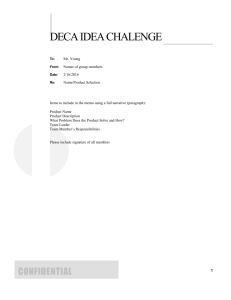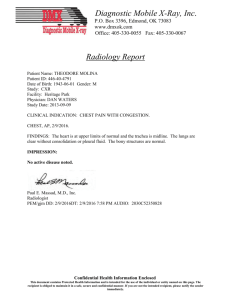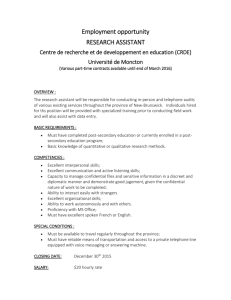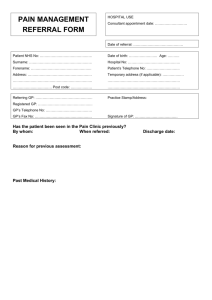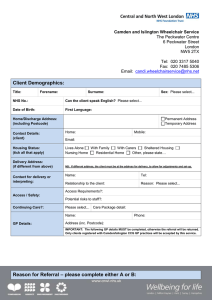Blue logo A4 template (Word) - Guy`s and St Thomas` NHS
advertisement
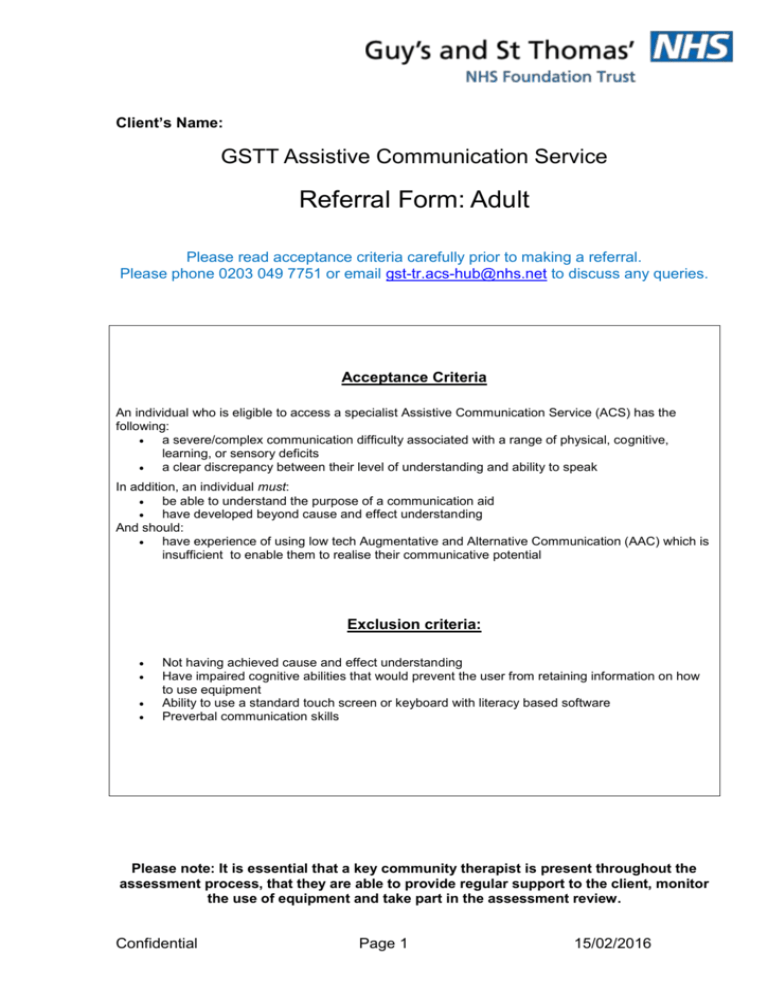
Client’s Name: GSTT Assistive Communication Service Referral Form: Adult Please read acceptance criteria carefully prior to making a referral. Please phone 0203 049 7751 or email gst-tr.acs-hub@nhs.net to discuss any queries. Acceptance Criteria An individual who is eligible to access a specialist Assistive Communication Service (ACS) has the following: a severe/complex communication difficulty associated with a range of physical, cognitive, learning, or sensory deficits a clear discrepancy between their level of understanding and ability to speak In addition, an individual must: be able to understand the purpose of a communication aid have developed beyond cause and effect understanding And should: have experience of using low tech Augmentative and Alternative Communication (AAC) which is insufficient to enable them to realise their communicative potential Exclusion criteria: Not having achieved cause and effect understanding Have impaired cognitive abilities that would prevent the user from retaining information on how to use equipment Ability to use a standard touch screen or keyboard with literacy based software Preverbal communication skills Please note: It is essential that a key community therapist is present throughout the assessment process, that they are able to provide regular support to the client, monitor the use of equipment and take part in the assessment review. Confidential Page 1 15/02/2016 SECTION 1: GENERAL CLIENT INFORMATION Name: Address: Tel: Mobile: Funding Borough: Date of Birth: NHS Number: Ethnicity: Gender: Male GP Address: GP Telephone Number: Female DETAILS OF DIAGNOSIS: Primary Diagnosis: Date of onset: Stable Deteriorating Improving Other significant medical history, if any: SECTION 2: REFERRER’S DETAILS Name Profession Address Relationship to client Phone Number E-mail Date REASON FOR REFERRAL: Please give detailed information of what goals the person and referrer would like to achieve from this referral: Confidential Page 2 15/02/2016 KEY PEOPLE INVOLVED – CARERS AND PROFESSIONALS AND CONTACT NUMBERS Family: Carer: Friends: Who will support the Client with equipment trial/use? CONSENT The Client consented to this referral? Y N If consent has not been given, please explain the reason: If this was a best interest decision, who made this decision? SECTION 3: PHYSICAL ABILITIES Please describe the person’s ability to use their upper limbs, including their fingers, hands and arms (e.g. tremor, spasticity, tone and active range of movement). Give examples of what activities the person can/cannot do with their hands. Please comment on the client’s head control. Please describe the person’s mobility. Are any of the following used? Manual wheelchair Model, if known _ __________________________ Powered wheelchair Model, if known__ _________________________ Waling aids (frame/ crutches) Walking unaided What seating is used for the majority of the day? (eg riser-recliner armchair/tilt in space wheelchair/bed.) Manual wheelchair ________________ Powered wheelchair Armchair Bed Other SECTION 4: EMOTIONAL STATE/CONTROL Describe any emotional / psychological factors which may affect the assessment. Confidential Page 3 15/02/2016 How does the client respond in frustrating situations? SECTION 5:SENSORY FUNCTION Give details of visual difficulties. Are glasses required? Y Give details of hearing difficulties. N Are hearing aids in place? Y N SECTION 6: COGNITION Please give details of any cognitive/learning disabilities which might impact on the ability to learn to use new equipment: LITERACY Can the Client read? Y N Can the Client write? Y N Can the Client use symbols? Y N SECTION 7: COMMUNICATION How does the person communicate currently: What strategies help? Does the person have a reliable YES/NO? Y N If Yes, how do they express YES/NO? Speech Therapy Diagnosis: Where does the person wish to communicate? With whom does the person wish to communicate? What low tech communication methods have been trialled? Confidential Page 4 15/02/2016 Which systems were successful and why? Which systems were unsuccessful and why? What HIGH TECH communication methods have been trialled? Which systems were successful and why? Which systems were unsuccessful and why? Client’s first language: Will an interpreter be required? Y N SECTION 8: COMPUTER USE Describe the client’s previous experience of using computers / tablets: Does the person have access to a computer at the moment? Y N Does the person have access to a tablet at the moment? Y N SECTION 9: ADDITIONAL INFORMATION NB. Where possible, we ask clients to travel to the Bowley Close Centre for appointments, as this enables our team to provide a comprehensive assessment with access to a full range of assessment equipment. Will this be possible for the client? Yes No Please provide as much detail as possible and any relevant reports, e.g. outcome measures of equipment trials, communication reports, medical reports and so forth. Confidential Page 5 15/02/2016 Guy’s and St Thomas’ Assistive Communication Service Guys and St Thomas’ NHS Foundation Trust Community Health Services Bowley Close Rehabilitation Centre Farquhar Road London SE19 1SZ Tel: 0203 049 7751 Fax 0203 049 7703 E-mail: gst-tr.acs-hub@nhs.net Confidential Page 6 15/02/2016
